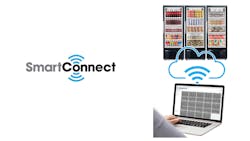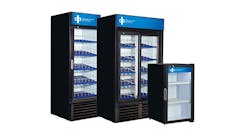How innovative IoT refrigeration applications contribute to micro market success
By Randy Skyba
What next? The micro market industry is always undergoing rapid change in consumer purchasing behavior; the past eight months are seeing an acceleration in unattended retail settings. Consider something like contactless payments for example, it has been growing steadily and the pandemic has created more demand and use for self-service technology. We can observe this in the micro market industry and in its immediate refrigeration cabinet requirements as businesses aim to provide safe ways for customers to purchase and pay for food and beverage products.
There’s a big move towards self-service checkout and digital payment options. Interactive machines associated with the proliferation of artificial intelligence (AI) and Internet of Things (IoT) are becoming wide-ranging and allow for improved business efficiency, enhanced customer service, simplified quality-assurance compliance, safety, improved communications, and more profitability, which means better sales.
Micro market food safety standards met with technology
Imagine if your refrigeration cabinets could provide data related to performance – they could give you the information you want, whenever and wherever you are in the world in real-time including instant notifications and text alerts or emails sent directly to you, so that you can proactively act on a merchandiser that may not be performing properly.
With today’s connected cabinets and components that safeguard stored food products by locking the merchandiser when a pre-set temperature limit is breached, owners can instantly diagnose and solve issues preemptively avoiding food spoilage, eliminating down time, and preventing customer frustration. A cloud-based system like SmartConnect can do all of this by accessing micro market merchandiser data including the temperature, door opening status, evaporator temperature, power failures, and compressor and defrost cycles.
Data help problem-solve refrigeration cabinet issues
Micro market owners can instantly diagnose and solve refrigeration cabinet issues by accessing reports containing minute, daily and weekly merchandiser data, which are handy if a health inspector decides to pay a visit.
If a customer calls to complain about soft ice cream, this can be handled offsite by checking the unit’s temperature and making small adjustments. This means no product spoilage, great customer service and cost savings from not having to make a service call. Even, consider the scenario where a customer accidently knocks over a food item in the cabinet that prevented the door from closing. Smart sensors can send a door alert to notify a customer or route driver to pick up the item and close the door properly. When it comes to connected cabinets, there are so many possible scenarios that can be avoided.
Connected refrigeration cabinets are a smart investment for micro market owners. Let’s say you received a high temperature notification on your phone, you can easily verify, remotely, several possible parameters causing the problem. If there’s an equipment issue, the operator could make a quick call to the manufacturer, and their customer service department can conduct a deeper analysis to determine the issue, which could be a faulty evaporator fan that needs replacing. Issues can be resolved instantly and remotely thanks to these new technologies.
The myriad of IoT related benefits for micro markets
Traditional micro markets have changed to appeal to consumer needs and wants in terms of safety and convenience. Refrigeration cabinets need to meet these demands. Other benefits of IoT-based commercial refrigeration cabinets include:
- Engaging a restocking alarm delay, can be done by a route driver who forgot to engage it. Shortly after leaving the high temp alarm goes off and the driver receives an instant text. After evaluating the data, the driver simply activates the alarm stock delay and everything goes back to normal, eliminating potential customer annoyances and a service call.
- Allowing for integration with providers of other solutions and technologies when it makes sense. For example, having a refrigeration cabinet communicate with a cooking system, so that when the customer takes a food product from the cooler shelf, a sensor is triggered to the oven for it to pre-heat for the food product that was purchased from the cabinet.
- Purchasing a product using their own tablet device or self-service equipment – customers make the food product purchase, the refrigerator cabinet unlocks and gives the customer access, so they can grab what they bought. Another more economical payment solution is having a tablet or touchscreen affixed to the cooler door where the customer can select what they want from the cabinet, then the customer scans the product and pays all from the same tablet or touchscreen.
- Integrating a level of grab and go technology into coolers and freezers. Amazon Go concepts are a reality for micro market operators. Providing consumers with access to fresh healthy food in a public space without the need for attended payment.
Groundbreaking smart technologies that create an automated and controlled micro market experience with end-to-end tracking is the future. The potential ways these new capabilities can be leveraged is almost endless and allow for peace of mind and profitability for operators. Check out the range of Minus Forty coolers and freezers that integrate new technologies for a frictionless micro market experience..







